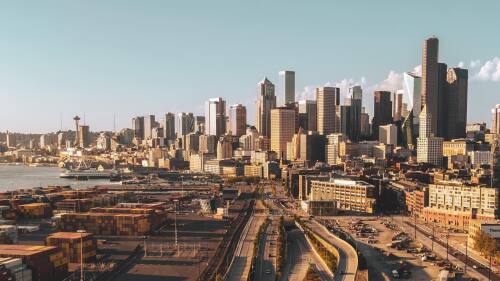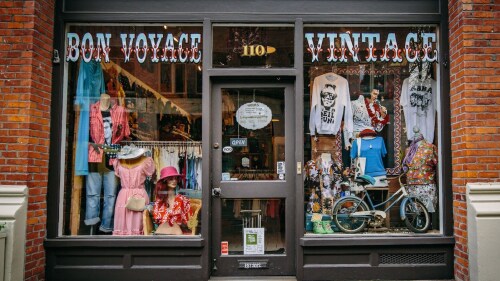The city of Seattle was incorporated on December 2, 1869, 16 years after Arthur Denny, Carson Boren, and David “Doc” Maynard filed the first official plats, helping to establish the downtown street grid we know to this day. Maynard was also likely the one who proposed naming the town after local tribal leader Chief Si’ahl. Now that 154 years have passed, the city and its streets are chock-full of vibrant history.
It’s safe to say that over the years, the city has been touched by countless historical figures and happenings — many of which have shaped the names of Seattle’s buildings, parks, and streets. In this guide, we’re delving into the history of Seattle’s streets — specifically how they were named.
Pioneer Square
Seattle’s original neighborhood had a pivotal point in 1852 when the Denny Party crossed over from their Alki settlement and the lumber industry began setting down roots. You might have heard of a certain Great Fire that burned the city’s then-downtown in 1889 — but Seattle rebuilt soon after and the rest is history.
Alaskan Way — a title referenced the Klondike gold rush that launched from our waterfront, though the city is proposing the honorary name Dzidzilalich (“little crossing-over place” in Lushootseed) to recognize the lands of the Puget Sound Coast Salish People.
Cherry Street — one of Seattle’s originally mapped streets is named for Cherry Grove, Illinois where the Denny Party began their journey to the West Coast.
Dilling Way — a small street named after one of the earliest mayors of Seattle, George W. Dilling, who served in the role from 1911-12, unseating the previous corrupt and “pro-vice” mayor Hiram Gill. Dilling tried to install reforms against saloons, gambling, and prostitution, but Gill became mayor again a few years later.
Prefontaine Place — named after Francis X. Prefontaine, a French-Canadian priest who founded the city’s first Catholic church.
Yesler Way — named after Henry Yesler, who established the region’s first steam sawmill, though it also earned the moniker “Skid Road” because of all the greased logs that were transported along it.
Capitol Hill
Not to be confused with the Capitol Hill in the other Washington, this neighborhood has a thriving nightlife scene and strong ties to the LGBTQ+ community. It’s a shame that it never became the actual capital of Washington state — early developers made the effort.
Barbara Bailey Way — a portion of East Denny Way renamed in honor of the late, beloved bookseller and LGBTQ+ rights activist.
Mercer Street — named for one of Seattle’s original pioneers who came up with Lake Union and Lake Washington’s monikers while on a picnic.
Minor Avenue — named for an early Seattle mayor with one major biographical oddity: he drowned off Whidbey Island on a duck-hunting trip.
Olive Way — named for Olive Julia Bell, the daughter of Seattle homesteaders Sarah and William Bell (of Belltown fame). It was almost renamed Harding Way after the 29th US president, but residents argued the street was too short to be worthy of a POTUS.
Terry Avenue— named for Charles Terry, a Seattle pioneer and merchandise salesman who built a bustling business in the 1850s at the ripe age of 23.
Central District
Bordered by Capitol Hill to the north and Mt. Baker to the south, this neighborhood lives up to its name as a bustling city hub. It’s an area with extensive Black history and culture, from the Northwest African American Museum to the Langston Hughes Performing Arts Institute.
Dearborn Street — named after Henry H. Dearborn who was among Seattle’s first real estate developers. It was formerly known as Mikado Street, the word for the title of emperor in Japanese.
Douglas Q. Barnett Street — the block of East Union Street between 34th and 35th Avenues is named after the local playwright who founded the influential Black Arts/West Theatre.
East Conover Court — named after Charles Tallmadge Conover, a 19th century newspaperman credited with dubbing Washington the “Evergreen State.”
Pike Street — named after John Pike, a carpenter who helped build the University of Washington.
Rev. Dr. S. McKinney Avenue — a portion of 19th Avenue near East Madison Street named for the prominent civil rights leader and original member of the Seattle Human Rights Commission. He also convinced Martin Luther King, Jr. to speak at Garfield High School.
Beacon Hill
One of many verdant neighborhoods in South Seattle is worth the steep strolls. Once nicknamed “Boeing Hill” because of how many residents worked for the aerospace company in the 50s and 60s, the area is now a diverse community with a robust dining scene and well-tended community greenspaces.
Cheasty Boulevard South — nope, not a Bond girl tribute, but rather named for E.C. Cheasty, a clothier and former police commissioner who helped establish Seattle’s boulevard system.
Roberto Maestas Festival Street — block of South Lander Street near 16th Avenue South named after the social justice icon who co-founded El Centro de La Raza.
South Angeline Street — named after Chief Si’ahl’s eldest daughter Kikisoblu, known as “Princess Angeline” by white settlers. Though she developed ties with settler families, when the Elliott Point Treaty of 1855 forced Native tribes from their ancestral lands, she refused to leave and stayed in her home near what’s now Pike Place Market.
South Holgate Street — named after John Cornelius Holgate, an Oregon Trail pioneer who traveled the Duwamish River and Elliott Bay by canoe in 1850.
South Massachusetts Street — one of many neighborhood roads inspired by the home state of Harwood Young, a 19th century investor instrumental in building Seattle’s streetcar system.














